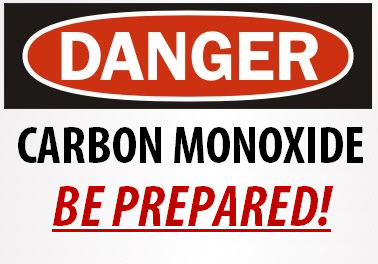
Whether you’re trying to get toasty at your campsite after a winter hike, heating ice shelters when fishing, heating up an off-the-grid cabin or warming a home with no electricity due to a winter storm power outage, there are a few key facts you need to know about safety practices relating to carbon monoxide poisoning prevention in order to protect yourself and loved ones.
Carbon monoxide is a colorless, odorless gas. It is produced by such things as portable generators,lanterns, burning charcoal and burning wood. A build-up of carbon monoxide in enclosed spaces can poison both people and animals;
Common symptoms include nausea, vomiting, confusion, dizziness, fatigue and headache. Pay special attention to flu-like symptoms if more than one person has them. Do not ignore symptoms. You can die within minutes if you do nothing.
If you suspect carbon monoxide poisoning, get into fresh outside air quickly, call emergency services and/or go to the nearest emergency room.
To protect yourself, follow safety tips listed below, as outlined by the Centers for Disease Control and the U.S. Fire Administration:
- Camping stoves, lanterns, charcoal grills and hibachi grills are intended for outdoor use only, as they require proper venting. Never use these tools inside, as doing so can lead to a dangerous buildup of carbon monoxide.
- Do not sleep or ride in a camper on a moving truck. The exhaust, another source of carbon monoxide, can be drawn into camper.
- While wood may be burned within the confines of an operational fireplace or wood-burning stove inside a home or cabin, take precautions to make sure these are properly vented and in working order. Experts recommend that these are inspected and cleaned each year by professionals to ensure safety.
- Note that the definition of “inside” extends beyond a house or apartment; do not use outdoor cooking and lighting tools inside your tent, cabin or camper, either. All of these enclosed environments have the potential to trap carbon monoxide.
- Be aware, alcohol adds to the dangers of carbon monoxide.
In addition to the safety practices listed above, experts recommend installing carbon monoxide detectors within your home.
Finally, keep the symptoms of carbon monoxide, as listed above, in mind. If you or your loved ones begin to exhibit these signs of carbon monoxide poisoning while indoors, get outside immediately and seek professional medical attention.
Be safe!
For more helpful information on camping, hunting, fishing and other outdoor activities, please browse the array of blog posts available on the Bass Pro Shops 1Source website.
- 3280 views

